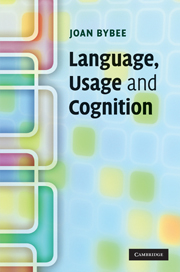Book contents
- Frontmatter
- Contents
- List of figures
- List of tables
- Acknowledgements
- 1 A usage-based perspective on language
- 2 Rich memory for language: exemplar representation
- 3 Chunking and degrees of autonomy
- 4 Analogy and similarity
- 5 Categorization and the distribution of constructions in corpora
- 6 Where do constructions come from? Synchrony and diachrony in a usage-based theory
- 7 Reanalysis or the gradual creation of new categories? The English Auxiliary
- 8 Gradient constituency and gradual reanalysis
- 9 Conventionalization and the local vs. the general: Modern English can
- 10 Exemplars and grammatical meaning: the specific and the general
- 11 Language as a complex adaptive system: the interaction of cognition, culture and use
- Notes
- Bibliography
- Index
9 - Conventionalization and the local vs. the general: Modern English can
Published online by Cambridge University Press: 05 June 2012
- Frontmatter
- Contents
- List of figures
- List of tables
- Acknowledgements
- 1 A usage-based perspective on language
- 2 Rich memory for language: exemplar representation
- 3 Chunking and degrees of autonomy
- 4 Analogy and similarity
- 5 Categorization and the distribution of constructions in corpora
- 6 Where do constructions come from? Synchrony and diachrony in a usage-based theory
- 7 Reanalysis or the gradual creation of new categories? The English Auxiliary
- 8 Gradient constituency and gradual reanalysis
- 9 Conventionalization and the local vs. the general: Modern English can
- 10 Exemplars and grammatical meaning: the specific and the general
- 11 Language as a complex adaptive system: the interaction of cognition, culture and use
- Notes
- Bibliography
- Index
Summary
Introduction
Given that chunking occurs with even low levels of repetition, there is much potential for word combinations to become conventionalized, accessed whole, and to accrue special uses or functions. In this chapter we study combinations of can and can't with verbs and their complements which have become conventionalized, some with special meaning or discourse function and some without. By using a large corpus of spoken American English (the Switchboard corpus) we discover certain regularities of usage that have escaped the notice of grammarians and which, indeed, defy many of the general principles of grammar. These ‘subgrammatical’ facts support the independence of conventionalization as one of the domain-general factors that is crucial to the emergence of grammar.
Of special interest also are cases where it appears that it is the meaning that has become conventionalized, not just the sequence of words. The role of meaning becomes apparent in cases where negation takes an alternate form, where can is replaced by be able to and where the requirement that a temporal phrase be present is met by that phrase in another clause. By conventionalization of meaning I mean that specific languages have specific concepts to which they call attention. Slobin (1996, 2003) refers to this phenomenon as ‘thinking for speaking’. Its effect on language is evident in patterns of lexicalization, as Slobin 1997a points out, and also in layering in grammaticalization, where a language may develop multiple grammaticalized expressions in the same domain, for example obligation or degrees of remoteness in tense systems.
Information
- Type
- Chapter
- Information
- Language, Usage and Cognition , pp. 151 - 164Publisher: Cambridge University PressPrint publication year: 2010
